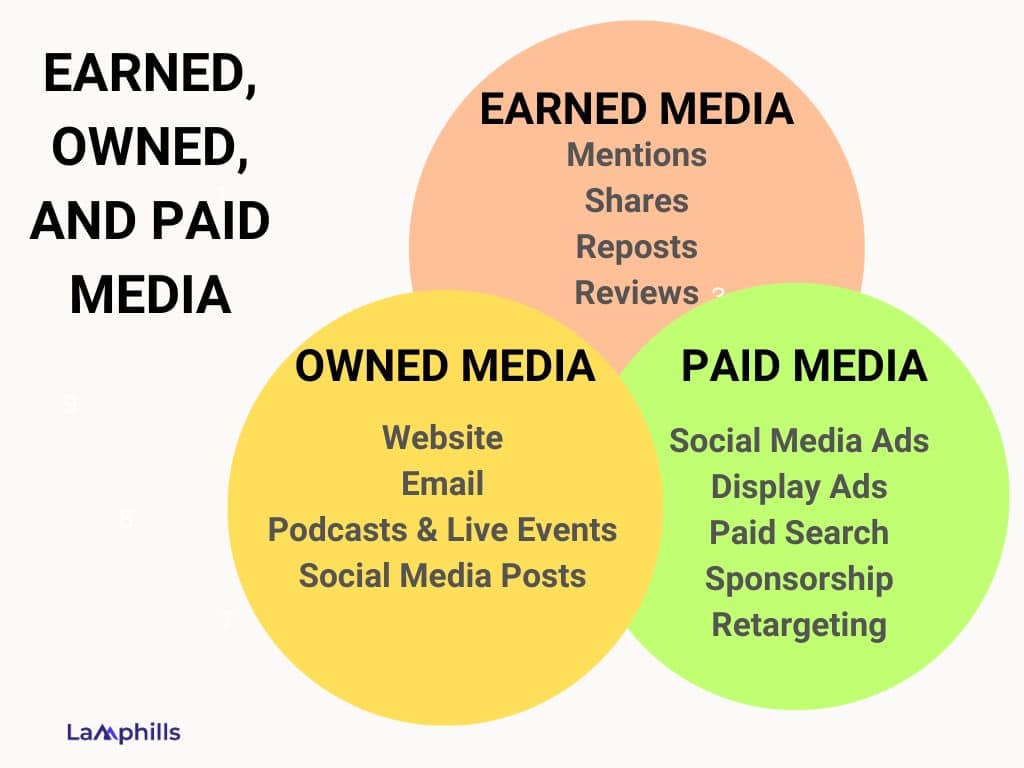Imagine where your brand gains exposure and recognition without you actively promoting it. Sounds intriguing, right? As an expert, I am here to shed light on the concept of earned media, including owned and paid media. You’ll also get to learn about earned media value examples, and the best practices to leverage its power effectively. So, sit back, relax, and read on.
Key Points
- Earned media is a powerful form of promotion that can boost brand visibility and credibility.
- Building relationships with key influencers and advocates is essential for maximizing the opportunities.
- High-quality products or services are crucial for generating positive organic mentions and reviews.
- To amplify positive reach and address any negative feedback needs monitoring and engaging with social media conversations.
- Measuring the impact helps to evaluate the success of your strategies and optimize future campaigns.
What is Earned Media?
Have you ever wondered how some companies get widespread media coverage without having to pay for advertising? The answer lies in the concept of earned media.
Earned media refers to publicity gained through promotional efforts other than paid advertising. This type of media coverage is mostly from third parties such as journalists and social media influencers. They choose to feature a company, product, or service based on its newsworthiness, relevance, or interest to their audience.
Unlike paid ones where companies pay for ad space or airtime, earned media is considered more credible and trustworthy. This is because it is seen as being endorsed by independent sources. Examples of earned media include news articles, online reviews, social media shares, and word-of-mouth recommendations.
An instance can be when a company launches a new product and sends out press releases to relevant media outlets. If the product is innovative or of interest to the public, journalists may choose to write about it, resulting in free publicity for the company.
In my business experience, I got social mentions when a local newspaper featured our company’s community outreach efforts in an article. This coverage not only helped raise awareness about our brand but also improved our reputation as a socially responsible business.
Owned, Paid, And Earned Media
Owned, paid, and earned media are three key types of media channels used in marketing and communication strategies. They help reach target audiences and promote brands or products. Each type of media serves a different purpose and has its advantages and challenges.
#1. Owned Media
Owned media refers to the channels that a company or brand owns and controls. This includes platforms such as websites, social media profiles, blogs, and email newsletters. Companies have full control over the content, messaging, and timing of owned media. This allows them to directly engage with their audience and showcase their brand identity.
Additionally, owned media provides an opportunity for companies to build brand awareness, establish credibility, and nurture customer relationships through consistent and relevant content. For more information, I recommend this article THE ULTIMATE GUIDE TO OWNED MEDIA: Best Strategies & Examples
#2. Paid Media
Paid media involves any promotional activities that require payment to reach a target audience. This includes online advertising, sponsored content, pay-per-click (PPC) campaigns, social media ads, and influencer partnerships.
Paid media allows businesses to extend their reach to a larger audience quickly, targeting specific demographics and interests to increase brand visibility and drive customer acquisition. So, while paid media offers immediate results, it requires a budget allocation to sustain campaigns and generate desired outcomes.
#3. Earned Media
Earned media refers to publicity or exposure that a company earns through word-of-mouth, shares, reviews, press coverage, and social platform mentions. Unlike owned and paid media, earned media are essentially free and are based on the merit of the company’s content or actions. It carries a high level of credibility and trust as it is from the audience’s perception rather than the company’s promotion. Companies can earn media in many ways: First, by delivering exceptional products or services, creating viral content, or engaging with influencers and media outlets to amplify their message.
I have had the opportunity to work with owned, paid, and earned media channels to promote various brands and products. If you want to manage owned media channels, then it requires a strategic approach. This helps to create engaging content that resonates with the target audience and aligns with the brand’s messaging. Paid media campaigns involve setting goals, targeting specific demographics, and analyzing performance metrics to optimize results and maximize return on investment.
Also, leveraging earned advertising involves building strong relationships with customers, influencers, and other outlets. Yeah! They’ll help generate positive word-of-mouth and organic exposure for your brand. So, now you’ve understood what owned, paid, and earned media entails, what’s your next step? Continue reading, as I still have more information you need to know!

Earned Media Value
Earned Media Value (EMV) refers to the publicity or exposure a brand receives through unpaid channels. This includes social media shares, mentions in the press, word-of-mouth referrals, or user-generated content.
In today’s digital marketing, where social media platforms have a massive influence on consumer behavior, EMV has become a crucial metric for brands to measure the effectiveness of their marketing efforts. Unlike paid ads, earned advertisements rely on organic interactions and endorsements from customers, followers, or influencers.
For instance, when someone shares a positive experience about a brand on social media, it can reach a wider audience and create a ripple effect of trust and credibility. Hence, this form of word-of-mouth marketing is highly valuable as it is more authentic and trustworthy than traditional advertisements.
To calculate Earned Media Value, marketers often use tools that quantify the impact of social media mentions, likes, shares, and comments. So, by assigning a monetary value to these interactions based on reach and engagement, your brand can measure the return on investment from the social media activities.
In a nutshell, Earned Media Value is a way to quantify the impact of a brand’s presence in the media without having to spend money on advertising. It is a valuable indicator of how well a brand is aligning with its target audience. Also, how influential its messaging is in generating buzz and engagement.
To break it down further, I have compiled the components that contribute to Earned Media Value in the document below.
The Components That Contribute To Earned Media Value
Earned Media Examples
Here are some examples of earned media and a brief explanation of each:
#1. Social Media Mentions
When customers talk about a brand, product, or service on social media platforms like Twitter, Facebook, or Instagram, it creates social mentions. These mentions can increase brand awareness and credibility among the audience.
I have experience with social media mentions as a marketing professional. By actively engaging with our audience on social media and encouraging user-generated content, we were able to increase our brand’s visibility and reach new customers.
#2. Influencer Partnerships
Collaborating with influencers in your industry can help generate earned media. When influencers promote your product or service to their followers, it can lead to increased visibility and trust in your brand.
Additionally, influencer partnerships have proven to be effective in driving traffic and sales for our e-commerce clients. So, by carefully selecting influencers whose values align with the brand, I leverage our following to generate buzz and increase brand awareness.
#3. Press Mentions
Getting featured in newspapers, magazines, blogs, or online publications through press releases or social pitches can result in earned media. Positive coverage from reputable media outlets can enhance your brand’s reputation and credibility.
#4. Customer Reviews and Testimonials
When satisfied customers leave positive reviews or testimonials about your products or services on review sites, social media, or your website, it creates earned media. Authentic reviews can influence potential customers and build trust in your brand.
#5. Viral Content
Creating engaging and shareable content that resonates with your audience can go viral and result in significant earned media. Viral content can reach a large audience organically and generate buzz around your brand.
These are just a few examples of earned media, which can be a valuable tool for building brand credibility and reaching a wider audience.
Why Is It Called Earned Media?
Earned media is called so because it is not paid for directly, but rather is “earned” through organic efforts. This includes public relations, word-of-mouth, and social sharing.
Let me explain with this popular saying, “You reap what you sow.” This means the efforts put into building a brand’s reputation and creating valuable content will eventually lead to earning media coverage and attention without having to pay for it directly.
Just like in farming, the more work and care put into cultivating a positive image, the more fruitful the earned media harvest will be.
What Is Earned Media And PR?
Earned media refers to publicity gained through promotional efforts rather than through paid advertising. It is essentially the attention and exposure a brand or company receives based on the quality of their product or service, their reputation, and the impact of their marketing and public relations efforts.
As for PR, or public relations, it involves managing the spread of information between an individual or organization and the public. This can include building relationships with key stakeholders, managing a company’s reputation, handling crisis communication, and generating positive media coverage.
When I think about earned media and PR, I see the power of creating a strong brand image and fostering positive relationships with the public. Through effective PR strategies and campaigns, I can help organizations earn media coverage and enhance their reputation to gain credibility and trust among their target audience.
In essence, earned media and PR are essential tools for businesses. They help to build a positive public image, establish credibility, and ultimately drive success in the marketplace.
What Is Earned Media Answer?
Earned media refers to publicity gained through promotional efforts other than advertising. That’s where the content is spread organically by word of mouth, online shares, mentions in the press, social media, or reviews.
It is essentially the exposure a brand receives through non-paid channels due to its noteworthy content, products, or actions. Hence, I will say that earned media is more credible and trustworthy by consumers. This is because it is mostly a third-party endorsement rather than a paid advertisement.
Is TV Earned Media?
Well, the answer is no. TV falls under the category of paid media since companies pay for airtime to reach their target audience. So next time you’re watching your favorite show, remember that those commercials are part of a paid advertising strategy, not earned.
Are Influencers Earned Media?
Yes, I believe that influencers can be considered earned media. Unlike paid advertising where brands pay to have their messages promoted, influencers have built their reputation, following, and credibility. When influencers mention or promote a brand organically, it is essentially word-of-mouth marketing generated through their influence and expertise in a particular niche.
Additionally, this endorsement can be seen as such because it is through the influencer’s efforts to create valuable content and engage with their audience. Brands often leverage influencers to reach a more targeted and receptive audience more authentically.
What Is The Difference Between Social Media And Earned Media?
I can confidently say that social media and earned media are two distinct but interconnected components of any successful marketing strategy. Yeah! Let me start with social media.
In my opinion, the main difference lies in the level of control and ownership. With social media, individuals and businesses have direct control over the content they share and the messages they convey to their audience. Also, they can choose the platform, the timing, and the specific content they want to publish.
On the other hand, earned media relies on the perceptions and actions of others. This involves customers, influencers, journalists, and reviewers. Additionally, it depends on how others perceive and talk about a brand or individual, rather than direct input or control.
While social media is a proactive tool for brands to create and share content, earned media is more about the recognition and validation that comes from external sources. Remember, both play crucial roles in a comprehensive marketing strategy. That’s to say, each offers unique benefits that can contribute to your brand’s overall success.
Related Articles
20 BEST MEDIA MONITORING TOOLS IN 2024
HOW TO MEASURE BRAND AWARENESS: Tips To Improve Your Brand Strategy
Top Media Outlets in 2024: A Trustworthy Guide for Authoritative News Sources






